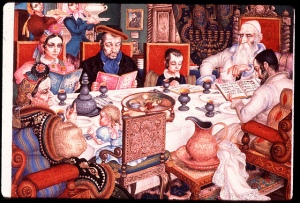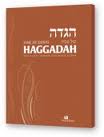Exploring an Awkward Halachic Problem
[This article is exclusively written for scholarly discussion purposes. It’s author, and his opinion expressed here, have no halachic authority or competence.]
The traditional halachah distinguishes between two manners of making fire: (1) creating a flame from a flame, and (2) creating a flame from a non-flame. On Yom Tov the first is permitted while the second is prohibited. [1] On Shabbat both are prohibited. On all other days both are permitted.
Creating a flame from a flame comprises three kinds of activity: (1) Transferring a flame from one place to another place; (2) Increasing the magnitude or intensity of a flame; (3) Numerically diversifying a flame, either by splitting it up or by extending it to other combustible material. [2]
I. The Problem: Extinguishing a Fire on Yom Tov
My purpose in this article is to address a particular problem which arises on Yom Yov. This is the problem that after cooking — a biblically permitted activity on Yom Tov (Ex. 12:16) — it is not permitted to extinguish the flame of the furnace. The reason for this prohibition is that extinguishing a flame is treated as the negative equivalent to creating it. So if I simply turn off the gas switch of the furnace after cooking, this is considered as the negative equivalent of striking a match. It is creating a non-flame from a flame, which is equally prohibited as the positive creating of a flame from a non-flame. [3]
The alternatives are either to leave the flame burning or to let it extinguish through some permissible cooking activity. The first alternative is often considered dangerous or alarming, especially if there are children around. The classic suggestion is here to put a pan of water on the furnace, using the same flame, for making soup or tea, and to let the water boil over it. This will cause the flame to be extinguished. This solution is often considered awkward and no less dangerous, either because of the risk of forgetting to turn the switch off after the flame is extinguished, or because this method is not infallible and the flame sometimes stays burning.
The question is thus: Are there no halachic reasons why extinguishing a flame could be considered permitted? Actually there are, and I’ll present three of them.
1. The Yom-Tov rule for creating a fire is that is should be derived from an existing flame. Extinguishing such a derived fire just seems to be the complementary equivalent to creating it. Therefore it seems that such a derived fire may be extinguished under the condition that its source flame keeps burning.
2. Extinguishing the flame after cooking marks the completion of the cooking process, and for that reason should be considered as part of this process. Since cooking is permitted, its completion must be permitted too.
3. The traditional prohibition leads to dangerous and awkward situations and thus to discouragement of cooking on the Yamim Tovim. Discouraging cooking cannot be the purpose of the halachah and the dangerous situations are detrimental of experiencing the typical joy of the holy day.
Against the first reason one can argue that, once a derived flame is brought into existence, it is a flame in its own right, which exists independently from its source flame. Its existence is only dependent on its fuel, the combustible material that was brought into contact with the source flame.
Extinguishing a derived flame is therefore not the exact opposite of its bringing into existence. In fact, there is no difference between extinguishing a flame that was derived from a source flame and extinguishing the source flame itself.
The halachic problem is thus that, although there is a difference in the coming into existence between a fire that is generated absolutely and one that is generated from another flame, there is no corresponding difference in the going out of existence between these two types of flames. The reason for this lack of a corresponding difference in the act of extinguishing is that the causal connection between the source flame and the derived flame only concerns the process of generation, the coming into existence.
The secondary or derived flame is not dependent on the source flame for its existence absolutely, but only for its coming into existence. There is no continuous dependence. Albeit the derived flame is generated by another flame, its dependence on this other flame ceases as soon as the generation process is completed. Producing fire by deriving if from an existing flame is thus a case of univocal causality: a new examplar of the same species is generated. Extinguishing a derived flame is a case of producing non-fire out of fire, which the exact complement of producing fire out of non-fire. Since the last is forbidden, the first is also forbidden.
II. A Possible Solution Considered
Perhaps there may be a way out here if we give a more detailed attention to the above mentioned three ways of creating fire from fire. Nobody considers it prohibited to bring back a flame to its original place or room, after it was removed and transferred to another place or another room. There are also authorities who find it permissible to lower the flame during or after the cooking process — although there is some opposition to this opinion. Now, if two of the three permitted activities of creating a flame from a flame have their permitted negative equivalent in a reversal of these activities, one would expect there to be such an equivalent for the third as well.
If we take the first activity, transferrring a flame to another location, we see that it is symmetrical, meaning that it’s negative equivalent is included in it. If we bring a burning candle from the dining room to the kitchen, the flame not only starts to exist in the kitchen but it also ceases to exist in the dining room. The cessation of existence in one location is here an inseparable aspect of its coming to existence in another location, in a continuous movement. This movement is purely accidental to the flame itself.
This symmetry is lost, however, when we compare the enlargement or intensification of a flame, the second activity, to diminishing its intensity or magnitude. By lowering the flame of a furnace we ‘destroy’ a part of it by making it smaller in size. If we increase the magnitude of a flame no such destruction occurs. The two changes here are not symmetrical. The destruction is not part of the increasing but only of the decreasing. For this reason some authorities are opposed to lowering a flame on Yom Tov, because of the partial destruction involved in it. Enlarging or diminishing its size affects the flame itself. And while the first is undoubtedly permitted, since it is the creating of fire from fire, the second is often considered of dubious permissibility since it involves a destruction, a partial creation of non-fire from fire.
When the third activity of making fire from fire, the numerical multiplication of a flame, is compared to its negative equivalent, extinguishing a derived flame, not only the above mentioned symmetry is lost. There’s the additional problem that the extinguishing itself doesn’t seem to be the proper equivalent of the kindling. For the kindling is done by means of another flame and is in the category of generating fire from fire. But the extinguishing is a simple destruction and is the return of fire to non-fire. So we again meet the obstacle that there doesn’t seem to be a real negative equivalent of the permissible action of creating new flames from existing ones.
We have to conclude now that the three kinds of activity: transferring, increasing and multiplying, are not comparable to each other in all respects. In the first the negative equivalent is simply included in the positive because of the symmetry of movement; in the second this negative equivalent is not included but is a separate action; in the third there doesn’t even seem to exist a real negative equivalent of the activity at all.
However, matters may not be exactly as they seem. For there’s an aspect in the extinguishing which until now was left out of our consideration. We saw in the above that the generation of a new flame from an existing one is a case of univocal causality, whereby a new individual of the same species is generated. It is this analysis in terms of individual and species which may be relevant here.
III. Analysis in Terms of Species and Individual
By a numerical expansion nothing new is created in the order of the species (flame), only in the order of the individual: the number of light- or fire-bearers is multiplied. What happens is not the generation of fire per se but only of instances of fire. Similarly, by a numerical reduction nothing is destroyed in the order of the species, only in the order of the individual: the number of light- or fire-bearers is reduced.
Now for the purpose of our analysis the species must here be accurately defined as fire or flame of Yom Tov (within the limits of a particular household).
It is clear when we hypothetically consider reducing the number of fire-bearers during Yom Tov as permitted, that care should be taken that this number is not reduced to zero. For then the species (i.e. the Yom Tov fire itself) would be extinguished. Reduction to zero corresponds to the situation in which a numerical expansion would start from zero, which is not permitted on Yom Tov because it implies the act of creating fire from non-fire.
Simply reducing the number without reducing it to zero can be considered permitted, however, because it is the negative equivalent of producing more flames from other flames. In this analysis such a reduction is not an act of making non-fire from fire. For before and after there is fire. It is an act of diminishing the number of flames, or instances of fire. If one considers the extinguishing of an individual flame here as making non-fire from fire, then, equivalently, the ignition of new combustible material (for instance new candles) in the multiplication of flames should be consisered as making fire from non-fire. But this would destroy the whole permission to multiply the number of flames by deriving a flame from another flame. And thus the logical consequence of this permission seems to be that reducing the number of flames is permitted. For fire is not extinguished absolutely or on the level of the species, but only an instance of it or on the level of the individual.
IV. Hypothetical Conclusion
This halachic option is dependent, as the reader will have noticed, on the opinion that accepts the permissibility of decreasing the intensity or magnitude of a derived flame. If the partial ‘destruction’ of an individual flame is prohibited, then obviously its total destruction will also be prohibited. If, however, the destruction of an individual flame is permitted under the condition that its source flame keeps burning, then obviously the partial destruction of an individual flame is also permitted.
If my conclusion is valid, the awkward and dangerous situations referred to in the exposition of the problem (in the first paragraph), can be easily avoided, without the specific halachic distinctiveness of Yom Tov being damaged.
A question which may possibly arise here is the following: What about the situation in which a Yom Tov fire is in existence and a new fire is produced directly, without deriving it from an existing flame? Is there no danger that this too would become permitted under this new halachic option? For this doesn’t seem to be an expansion from zero to one, because there was already a flame burning.
The answer to this question is simply that a newly created flame is outside the species of Yom Tov fire. For it belongs to the nature or definition of Yom Tov fire that it isn’t created from non-fire. Therefore this procedure would still be not permissible. Under this halachic perspective it would thus remain prohibited to extinguish a Yom Tov source flame, i.e. a flame which was already burning before the arrival of Yom Tov and which was kindled in advance in order to derive other flames from it during Yom Tov.
_______________
[1] Ganzfried III.98.1: “Carrying objects from one place to another, and kindling a fire are also permitted on a festival, even when not needed for cooking but for some other purpose.”
Ganzfried III.98.31: “It is not permissible to draw fire on a festival, either from a flint, , or a glass, or a match.” [R. Solomon Ganzfried, Kitzur Shulchan Aruch, Hebrew Publishing Company — New York 2004 (1961).]
[2] Zevin I.23: “To produce fire (as opposed to using, increasing, or transferring an already burning flame) is forbidden.” [R. Shlomo Yosef Zevin, The Festivals in Halachah Vol I, Mesorah Publications — New York 2002 (1981).]
[3] The reason why simply creating a flame from a non-flame is prohibited is the legal principle that those parts of food preparation which can be done beforehand, without diminishing the quality of the food, should not be done on the Yom Tov. The prohibition of producing fire is held to be scriptural by some because they hold this legal principle to be scriptural.





Recent Comments